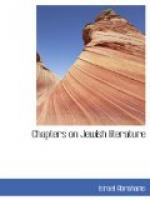Salman, the son of Yerucham, was an active traveller; born in Egypt, he went as a young man to Jerusalem, which he made his head-quarters for several years, though he paid occasional visits to Babylonia and to his native land. These journeys helped to unify the scattered Karaite communities. Besides his Biblical works, Salman composed a poetical treatise against the Rabbinite theories. To this book, which was written in Hebrew, Salman gave the title, “The Wars of the Lord.”
Sahal, the son of Mazliach, on the other hand, was a native of the Holy Land, and though an eager polemical writer against the Rabbinites, he bore a smaller part than Salman in the practical development of Karaism. His “Hebrew Grammar” (Sefer Dikduk) and his Lexicon (Leshon Limmudim) were very popular. Unlike the work of other Karaites, Joseph al-Bazir’s writings were philosophical, and had no philological value. He was an adherent of the Mohammedan theological method known as the Kalam, and wrote mostly in Arabic. Another Karaite of the same period, Hassan, the son of Mashiach, was the one who impelled Saadiah to throw off all reserves and enter the lists as a champion of Rabbinism. Of the remaining Karaites of the tenth century, the foremost was Japhet, the son of Ali, whose commentaries on the Bible represent the highest achievements of Karaism. A large Hebrew dictionary (Iggaron), by a contemporary of Japhet named David, the son of Abraham, is also a work which was often quoted. Kirkisani, also a tenth century Karaite, completed in the year 937 a treatise called, “The Book of Lights and the High Beacons.” In this work much valuable information is supplied as to the history of Karaism. Despite his natural prejudices in favor of his own sect, Kirkisani is a faithful historian, as frank regarding the internal dissensions of the Karaites as in depicting the divergence of views among the Rabbinites. Kirkisani’s work is thus of the greatest importance for the history of Jewish sects.
Finally, the famous Karaite Judah Hadassi (1075-1160) was a young man when his native Jerusalem was stormed by the Crusaders in 1099. A wanderer to Constantinople, he devoted himself to science, Hebrew philology, and Greek literature. He utilized his wide knowledge in his great work, “A Cluster of Cyprus Flowers” (Eshkol ha-Kopher), which was completed in 1150. It is written in a series of rhymed alphabetical acrostics. It is encyclopedic in range, and treats critically, not only of Judaism, but also of Christianity and Islam.
Karaitic literature was produced in later centuries also, but by the end of the twelfth century, Karaism had exhausted its originality and fertility. One much later product of Karaism, however, deserves special mention. Isaac Troki composed, in 1593, a work entitled “The Strengthening of Faith” (Chizzuk Emunah), in which the author defended Judaism and attacked Christianity. It was a lucid book, and as its arguments were popularly arranged, it was very much read and used. With this exception, Karaism produced no important work after the twelfth century.




